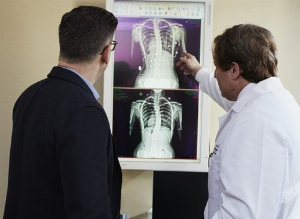Multiple myeloma: Everything you need to know!
Published Oct 7, 2021 • By Candice Salomé
Multiple myeloma, also known as Kahler's disease, is a type of cancer that affects about 30,000 people in the US every year. This bone marrow disease caused by the abnormal accumulation of plasma cells, a type of white blood cells, is not very well-known.
But what really is multiple myeloma? How can it be diagnosed? What are its causes and symptoms? Is it a hereditary disease?
Read our article to find it all out.

What is multiple myeloma?
Multiple myeloma, also known as myeloma, or Kahler's disease, develops when a certain type of white cells (called plasma cells) mutate and start multiplying rapidly and in a chaotic way.
Plasma cells are part of the immune system and participate in the body's defensive reactions. They are produced by the spleen from B lymphocytes. Plasma cells migrate to all the organs but are mostly found in bone marrow. Their role is to secrete antibodies and neutralise foreign substances.
Normally, plasma cells do not have the capacity to multiply and bone marrow doesn't contain a lot of them.
However, the plasma cells of a patient diagnosed with myeloma, will accumulate in bone marrow of multiple bones. These abnormal plasma cells will stimulate other cells that are in charge of normal destruction of bone tissue (osteoclasts) and suppress the cells in charge of bone formation (osteoblasts). This leads to the break-down of bone renewal, which is based on the balance between the mechanisms of destruction and reconstitution.
Bones become weakened, which potentially causes fractures. This phenomenon also leads to decrease in the production of healthy blood cells.
Myeloma is called multiple because several bones are attacked simultaneously.
What are the symptoms of multiple myeloma?
About 20 % of people affected by multiple myeloma have no symptoms whatsoever.
Patients that do present symptoms, may find themselves suffering from:
- bone pain or pain in the spine, which resists to pain killers,
- bone fractures,
- pain, trouble moving or numbness (also tingling and lack of feeling in arms or legs, trouble moving their fingers...),
- signs linked to increased blood viscosity caused by the great number of circulating immunoglobulins: visual impairments, headaches, confusion...
- signs linked to high levels of calcium in the blood (caused by the destruction of bones which releases large quantities of calcium): dry mouth, nausea, vomiting...
- signs linked to the accumulation of antibodies in certain organs: irregular heartbeat, abnormal and painful feelings in hands and feet, wrist pain...
- recurrent infections linked to the decrease in the production of B lymphocytes by bone marrow: bronchopneumonia, cystitis...
- anemia caused by the decrease in the production of red blood cells by bone marrow which leads to tiredness and shortness of breath after a physical effort.
What are the causes of multiple myeloma?
As of today, no cause or risk factor was formally identified, apart from the accidental exposure to ionising radiation (radioactivity).
Research is currently being carried out to identify a possible genetic predisposition.
How is multiple myeloma diagnosed?
A patient affected by multiple myeloma often finds out about the disease by accident. In fact, it often depends on its stage of evolution. In the absence of clinical or biological signs, multiple myeloma can be suspected during a routine check-up, a blood test or via medical imaging.
When multiple myeloma progresses, it can provoke clinical or biological signs. Their presence will in this case lead the doctor to suspect the disease and will be the starting point for establishing a diagnosis. Some of the signs are: hypercalcemia, anemia, one or several bone damages, kidney disease or repeated infections.
To establish the diagnosis, the doctor will first of all carry out a clinical examination. Then, various biological examinations can be added, especially protein electrophoresis* and bone marrow biopsy**. Medical imaging can also be prescribed.
*A method that separates proteins depending on their weight and electric charge. The graph is examined and the morphology of different fractions is interpreted.
**Bone marrow biopsy is a medical procedure during which a small sample of bone marrow is removed from breast or hip bone.
How does the disease progress and what complications can it have?
For 60 to 70% of patients affected by myeloma, the disease causes renal complications. The immunoglobulins found in great quantities in the bloodstream, tend to accumulate in kidneys and disturb their normal functioning.
Moreover, acute kidney (renal) failure may be observed in the most severe cases. Its main symptoms are: fatigue, swelling of legs and feet, abnormally low or, on the contrary, increased urine output.
Therefore, the prevention of acute kidney failure is essential. This means avoiding dehydration and medication that can cause it (non-steroidal anti-inflammatory drugs such as ibuprofen and ketoprofen, or iodinated contrast agents used for some medical imaging exams).
Finally, the presence of multiple myeloma increases the risk of developing certain cancers such as colon cancer and breast cancer. Patients affected my myeloma and aged between 50 and 74 must undergo bi-annual screening for the above-mentioned types of cancer.
If not treated, this disease puts the patient's life at risk, mainly because of its effects on kidneys, bones and blood. In the United States, the overall 5-year survival rate is 53%.
How can multiple myeloma be treated?
The aim of the treatment for multiple myeloma is to ease the symptoms and prevent the progression of the disease and its complications. The treatments we have today do not allow to cure the disease, but they help make it treatable, though still chronic.
The care team base their decision whether to start a treatment on 4 elements: an increased level of calcium in the blood, acute kidney failure, anemia and bone damage.
In the absence of these elements, the patient does not usually receive treatment, but is closely monitored. This is called therapeutic abstention.
Patients who present with an advanced stage of the disease are prescribed chemotherapy.
Finally, patients under 65 may receive stem cell/bone marrow transplant, also called an "autograft".
Similarly to the treatment of most of other cancers, treatment for multiple myeloma follows a codified protocol adapted to each patient.
Give it a like or share your thoughts and questions with the community in the comments below!
Take care!
Comments
You will also like

Multiple Myeloma: “I roll with the punches, stay active when I can, and rest when I need to.”
Apr 17, 2024

 Facebook
Facebook Twitter
Twitter

